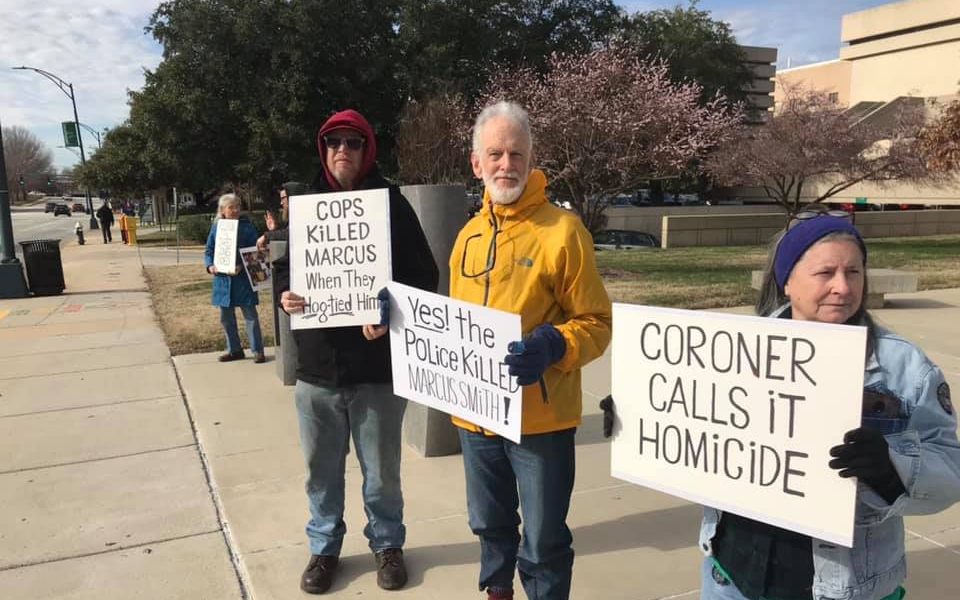A weekly protest in support of Marcus Smith, a man who died
last September after being hog-tied by Greensboro police officers, continued today
as a handful of people picketed in front of Melvin Municipal Office Building.
Hester Petty, who organized the weekly “Mondays for Marcus”
protests, said she wants to see police Chief Wayne Scott fired over the
handling of the incident, and wants the department to prohibit the maximum restraint
position in which a subject’s ankles and wrists are bound behind their back.
Smith stopped breathing shortly after officer applied the restraint while he was
face down on the ground.
Petty said she also wants the Guilford County District Attorney to charge three officers who were most closely involved in the incident with involuntary homicide.
Doug Henderson, who put in his last day as district attorney
on Jan. 2, notified Chief Scott in a Dec. 28 letter that the officers were not
criminally negligent in Smith’s death, which was ruled a homicide by the NC
Office of the Chief Medical Examiner.
“As applied to these circumstances, criminal negligence
means a carelessness or recklessness that shows a thoughtless disregard of
consequences or a heedless indifference to the safety of another,” Henderson
wrote. “The overwhelming showing based on all of the investigative materials
presented to this office demonstrates that these officers mean to help and not
hurt Mr. Smith. The loss of this life is tragic, but there is no evidence to
substantiate a criminal act.”
Larry Morse, one of six people picketing the city building
on Monday, questioned the former district attorney’s decision.
“It’s strange that the DA says officers are trying to help
him,” Morse said. “While they were actually hog-tying him, they weren’t paying
much attention to him — if he was breathing and what he was saying.”
Henderson’s letter referenced the department policy on the
use of the “Ripp Hobble” restraining device. Without stating directly whether
the officers violated the policy, Henderson noted that the policy “specifically
describes the manner in which a person in custody should be positioned during
the time of transportation (seated in an upright position or on their side) so
as to avoid harming that person.” Henderson went on to say, “In this instance,
Mr. Smith became unresponsive immediately after he was necessarily placed in
the additional restraints and before he could be transported to the hospital in
the manner described. Mr. Smith was at no time transported while in the ‘Ripp
Hobble’ device.”
The departmental policy that covers the use of the Ripp
Hobble device, GPD Directive 11.1.4, falls under a section entitled “Handling
and Transporting Persons In Custody.” The directive states, “In addition to the
wrists, the feet or the ankles of the arrestee may be secured to restrict the independent
movement of the feet and legs. For this purpose, training is provided in the use
of the Ripp Hobble restraining device. If further immobility is needed, the
secured wrists and ankles may be linked together using flexicuffs or the hobble
device. At no time shall the wrists and ankles of an arrestee may be linked
together using flexicuffs or the hobble device.” The directive goes on to say, “At
no time shall the wrists and ankles of an arrestee be linked together using the
Ripp Hobble restraining device, unless the arrestee can be seated in an upright
position, or on their side.”
Chief Scott previously told City Beat that the directive only applies to the transport of
persons in custody, and doesn’t cover the circumstances of the Smith incident.
He added that the department doesn’t have a specific directive that applies to
applying the restraint.
Some local law enforcement agencies prohibit the maximum restraint
position. The Winston-Salem Police Department “strictly prohibits” the maximum
restraint position in its Use of Force policy, according to Police Attorney
Lori Sykes. The department’s General Orders on Use of Force defines the maximum
restraint position as “placing a subject with hands secured behind their back,
legs secured together, and their legs and hands connected together behind the
subject’s back with the subject’s legs flexed at the knees. Subject is laying
on their side or face-down.”
The Guilford County Sheriff’s Office allows for the use of
the hobble device to restrain a person’s feet and legs during transport, but
the policy cautions that “this device is not to be used to bind a person’s arms
behind them or hog-tie a person.” Officers typically secure a person in custody
for transportation by catching the loose end of the strap in a closed backdoor
of the vehicle.
Petty said the fact that the district attorney’s office
notified the police that there were no issues of criminal liability at least a
month prior to the completion of the SBI investigation undermines the
credibility of the district attorney’s final determination. In early December,
when the Office of the Chief Medical Examiner released its homicide finding, a
representative of the district attorney’s office clarified that the earlier
determination was “preliminary” and not “final.”
Petty said she wrote a letter to Avery Crump, the new
district attorney saying that she is suspicious of Henderson’s determination,
and she hopes Crump will revisit the decision.
A representative of the district attorney’s office could not
be reached for comment at the time of publication.
Join the First Amendment Society, a membership that goes directly to funding TCB‘s newsroom.
We believe that reporting can save the world.
The TCB First Amendment Society recognizes the vital role of a free, unfettered press with a bundling of local experiences designed to build community, and unique engagements with our newsroom that will help you understand, and shape, local journalism’s critical role in uplifting the people in our cities.
All revenue goes directly into the newsroom as reporters’ salaries and freelance commissions.


Leave a Reply